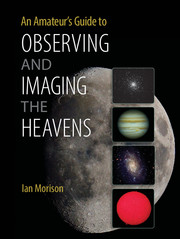Book contents
- Frontmatter
- Dedication
- Contents
- Preface
- Acknowledgements
- Prologue A Tale of Two Scopes
- 1 Telescope and Observing Fundamentals
- 2 Refractors
- 3 Binoculars and Spotting Scopes
- 4 The Newtonian Telescope and Its Derivatives
- 5 The Cassegrain Telescope and Its Derivatives
- 6 Telescope Maintenance, Collimation and Star Testing
- 7 Telescope Accessories
- 8 Telescope Mounts
- 9 The Art of Visual Observing
- 10 Visual Observations of the Moon and Planets
- 11 Imaging the Moon and Planets
- 12 Observing and Imaging the Sun
- 13 Observing and Imaging with an Astro-Video Camera
- 14 DSLR Deep-Sky Imaging
- 15 Imaging with Cooled CCD Cameras
- 16 Auto-Guiding and Drift Scan Alignment
- 17 Spectral Studies
- 18 Improving and Enhancing Images in Photoshop
- Index
- Plate Section
10 - Visual Observations of the Moon and Planets
Published online by Cambridge University Press: 05 June 2014
- Frontmatter
- Dedication
- Contents
- Preface
- Acknowledgements
- Prologue A Tale of Two Scopes
- 1 Telescope and Observing Fundamentals
- 2 Refractors
- 3 Binoculars and Spotting Scopes
- 4 The Newtonian Telescope and Its Derivatives
- 5 The Cassegrain Telescope and Its Derivatives
- 6 Telescope Maintenance, Collimation and Star Testing
- 7 Telescope Accessories
- 8 Telescope Mounts
- 9 The Art of Visual Observing
- 10 Visual Observations of the Moon and Planets
- 11 Imaging the Moon and Planets
- 12 Observing and Imaging the Sun
- 13 Observing and Imaging with an Astro-Video Camera
- 14 DSLR Deep-Sky Imaging
- 15 Imaging with Cooled CCD Cameras
- 16 Auto-Guiding and Drift Scan Alignment
- 17 Spectral Studies
- 18 Improving and Enhancing Images in Photoshop
- Index
- Plate Section
Summary
This is a wonderful branch of the hobby and one that can be pursued even in heavily light-polluted skies. What does one need? Well, of course, any telescope will do but, as has been discussed earlier, telescopes which have an inherently high contrast are best. Many of the planetary surface features are of low contrast, and for viewing the Moon, which will be very bright both inside and, at higher magnifications, outside the field of view, the overall contrast of the telescope becomes quite important. Refractors are best for both overall contrast and micro-contrast but are very expensive in larger apertures. If a reflecting telescope is to be used for lunar observations, mirrors with high-reflectivity coatings will prove significantly better, and these will also improve planetary observations − but to a lesser extent, as there is far less light entering the telescope and hence less that can be scattered by the mirror surfaces. Maksutov-Newtonians are a very close second to refractors in terms of their micro-contrast and greater affordability in larger apertures. Newtonians with focal ratios of f6 and above and Maksutovs come next, and even Schmidt-Cassegrains, if well collimated, can give very worthwhile views. So this is not something to get hung up about. The best telescope for observing is the one that you have!
As the angular sizes of the planets are small, high magnifications are needed, with the use of up to 200 on a reasonable night when the seeing is good. Such magnifications would also be used for exploring lunar features. Higher magnifications can be used on nights of exceptional seeing. One useful accessory is a zoom eyepiece. This can help you find the optimum magnification to suit your telescope, eye and the seeing. Reduce the local length until the image quality begins to fall off and then choose the nearest focal length eyepiece in your collection. Simple eyepieces, such as Plössls and orthoscopics, contain less glass and fewer air/glass interfaces than wide-field types, so they can be very good for lunar and planetary observing. It is probably best not to use eyepieces with too short a focal length, as their eye relief can be very small; instead, use a greater-focal-length eyepiece with a ×2 Barlow lens. Using a binoviewer can also add something to the visual experience.
- Type
- Chapter
- Information
- An Amateur's Guide to Observing and Imaging the Heavens , pp. 160 - 177Publisher: Cambridge University PressPrint publication year: 2014



